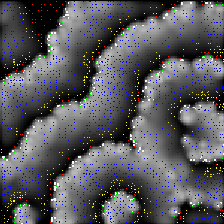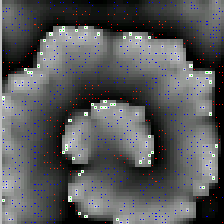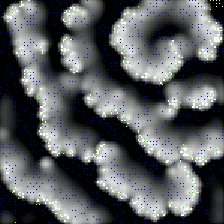





The slime mold Dictyostelium discoideum is one of the most studied organisms in developmental biology. Dictyostelium occupies a major gap between simple yeasts and higher organisms and affords excellent opportunities for studying the development of multicellularity.
Known as "social amoebae", Dictyostelium cells live independently in the soil as long as food (bacteria) is present. When food is scarce, starved cells enter a process of aggregation, differentiation, and morphogenesis that results in a multicellular organism. The cells use chemical signalling to aggregate up to 100,000 amoebae into a mound. The cells differentiate and the mound becomes a slug which moves around until it finds appropriate light, humidity, and external ammonia conditions. The slug then transforms into a fruiting body with a stalk and a mass of spores. The spores are dispersed and the life cycle begins anew. Approximately 80% of the original cells become spores -- the 20% of the cells that become the stalk altruistically donate their lives.
The slime mold aggregation is controlled by chemotaxis toward higher concentrations of cyclic adenosine monophosphate (cAMP). (cAMP is a common intracellular messenger in higher organisms.) The onset of starvation causes some cells to produce and secrete cAMP. Extracellular cAMP binds to receptors on cells and initiates two processes. The first, and faster, process activates the adenylate cyclase enzyme which causes production of cAMP. This cAMP is secreted; it can then bind to the same cell, further stimulating cAMP production, and to other cells. The second slower process leads to inhibition of adenylate cyclase. This second process stops the autocatalysis. The extracellular cAMP diffuses away and is degraded by phosphodiesterase, which is secreted by the slime mold cells. Once the level of cAMP has fallen the cells begin to regain the ability to synthesize cAMP.
The autocatalytic production and following inhibition cause a cAMP wave to propagate through a colony of slime mold cells. As the cAMP diffuses out it excites cells that relay the wave by producing more cAMP. When the cells become refractory (insensitive to further cAMP due to the inhibition), the wave moves on. These waves form spiral patterns that are similar to other spiral waves in excitable media, such as the Belousov-Zhabotinsky reaction ( simulated here) or the catalysis of carbon monoxide on a platinum surface.
Starving slime mold cells are an excitable medium because of the positive feedback of cAMP binding and production. Waves in excitable media annihilate each other as they meet due to the refractory period. Spiral waves form when a wavefront encounters a non-excitable obstacle and breaks. Spiral waves are a common phenomenon in excitable media; once formed they tend to take over the wavefield due to their high frequency.
Binding of extracellular cAMP also causes chemotaxis towards higher cAMP concentrations. Cells keep moving as long as the cAMP level is rising, but stop as soon as the cAMP level begins to decrease (in order to avoid moving after the wave as it propagates outward). This results in periodic movement towards the source of the cAMP waves ("aggregation centers"), the cells moving inwards each time a wave passes.
KL93 describes a model for simulating pattern formation during slime mold aggregation. LATT96 extends the model to include variable cell excitability. FL98 adds to the model considerably by modeling the important elements of the genetic circuit involved in cAMP signalling. I will refer to these models as "the first model", "the second model", and "the third model", respectively. They all attempt to determine how an initially featureless system evolves into a patterned wavefield.
My project's goal is to duplicate the simulation results of both the first and second models. The third model is much more complicated and I will not attempt to use it in this project.
The rest of the pages are organized as follows. First, the models are explained. Then my simulator is described. Results and conclusions follow.
My simulator is available as a Java applet.

| >>Introduction<< | Models | Simulator | Results | References |